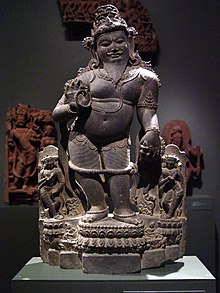Portal:Sangam period
Introduction

The Sangam literature (Tamil: சங்க இலக்கியம், caṅka ilakkiyam), historically known as 'the poetry of the noble ones' (Tamil: சான்றோர் செய்யுள், Cāṉṟōr ceyyuḷ), connotes the early classical Tamil literature and is the earliest known literature of South India. The Tamil tradition and legends link it to three legendary literary gatherings around Madurai and Kapāṭapuram: the first lasted over 4,440 years, the second over 3,700 years, and the third over 1,850 years. Scholars consider this Tamil tradition-based chronology as ahistorical and mythical. Most scholars suggest the historical Sangam literature era, also called the Sangam period, spanned from c. 300 BCE to 300 CE, while others variously place this early classical Tamil literature period a bit later and more narrowly but all before 300 CE. According to Kamil Zvelebil, a Tamil literature and history scholar, the most acceptable range for the Sangam literature is 100 BCE to 250 CE, based on the linguistic, prosodic and quasi-historic allusions within the texts and the colophons.
The Sangam literature had fallen into oblivion for much of the second millennium of the common era, but were preserved by and rediscovered in the monasteries of Hinduism, near Kumbakonam, by colonial-era scholars in the late nineteenth century. The rediscovered Sangam classical collection is largely a bardic corpus. It comprises an Urtext of oldest surviving Tamil grammar (Tolkappiyam), the Ettuttokai anthology (the "Eight Collections"), the Pathuppaattu anthology (the "Ten Songs"). The Tamil literature that followed the Sangam period – that is, after c. 250 CE but before c. 600 CE – is generally called the "post-Sangam" literature.
This collection contains 2381 poems in Tamil composed by 473 poets, some 102 anonymous. Of these, 16 poets account for about 50% of the known Sangam literature, with Kapilar – the most prolific poet – alone contributing just little less than 10% of the entire corpus. These poems vary between 3 and 782 lines long. The bardic poetry of the Sangam era is largely about love (akam) and war (puram), with the exception of the shorter poems such as in Paripaatal which is more religious and praise Vishnu and Murugan. The Sangam literature also includes Buddhist and Jainist epics.
Full article...)Selected general article

The ancient Tamil music is the historical predecessor of the Carnatic music during the Sangam period spanning from 500 BCE to 200 CE.
Many poems of the classical Sangam literature were set to music. There are various references to this ancient musical tradition found in the ancient Sangam books such as Ettuthokai and Pattupattu. The early narrative poem Cilappatikaram, belonging to the post-Sangam period (5th or 6th century) also mentions various forms of music practiced by the Tamil people.
Music was an integral part of the compositions of the Tamil Saiva saints such as Appar, Siva Prakasar, Thirugnana Sambanthar and Manikkavasagar during the Hindu revival period between the 6th and the 10th century. (Full article...)
Selected Sangam literature article
Iniyavai Narpathu (Tamil: இனியவை நாற்பது, romanized: Iṉiyavai Nāṟpatu, lit. 'The Forty Desirable Things') a classic Tamil poetic work of didactic nature belonging to the Eighteen Lesser Texts (Pathinenkilkanakku) anthology of Tamil literature. This belongs to the post Sangam period corresponding to between 100 and 500 CE. Iniyavai Narpathu is a collection of 40 poems written by the poet Putham Sernthanar describing the most desirable things in life. The poems of Iniyavai Narpathu are written in the Venpa meter.
This collection is very similar to Inna Narpathu, which deals with the forty things one should avoid. Iniyavai Narpathu includes four categories of things one should seek in life: learning even at the expense of begging, the advice of learned persons, healthy children, strength to not covet other's spouse.
Iniyavai Narpathu, together with Inna Narpathu spells out in simple and succinct terms moral codes essential for daily life of the individual and for the society. They both emphasise the importance of education and individual responsibility in society. (Full article...)
Selected images
Selected biography
Nedum Cheralathan was a Chera ruler of the early historic south India (c. 1st - 4th century CE), contemporary to the Chola ruler Perunarkilli. He is the second known Chera ruler from the early Tamil literature, and is praised in the Second Ten of Pathitruppaththu (composed by poet Kannanar). He patronized Jainism and Buddhism.
Nedum Cheralathan succeeded his father (Uthiyan Cheralathan) and ruled the territory for 58 years (as a crown prince first and then as an absolute ruler). He was a successful ruler with several victories over neighbouring rulers such as the Kadambas. He is believed to have won over "seven crowned kings" and thus obtained the status of "adhiraja". He defeated an enemy on the Malabar Coast and captured several Yavana traders, later releasing them for ransom. Nedum Cheralathan fought a battle against a Chola ruler, an encounter in which both the principal adversaries lost their lives. (Full article...)
Categories
Get involved
Revive the WikiProject Tamil civilization.
Associated Wikimedia
The following Wikimedia Foundation sister projects provide more on this subject:
-
Commons
Free media repository -
Wikibooks
Free textbooks and manuals -
Wikidata
Free knowledge base -
Wikinews
Free-content news -
Wikiquote
Collection of quotations -
Wikisource
Free-content library -
Wikiversity
Free learning tools -
Wiktionary
Dictionary and thesaurus














